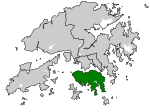Highcliff

Highcliff is a luxury apartment on a south slope of Happy Valley on the Hong Kong Island in Hong Kong. The 75-storey building's construction (70 floors of which are liveable space) began in 2000 and was completed in 2003 under a design by DLN Architects & Engineers. It was the Silver Winner of the 2003 Emporis Skyscraper Award, coming in second to 30 St Mary Axe in London. The tower is the tallest "all"-residential building in Hong Kong island. Highcliff is thin for such a tall building; it has a slenderness ratio of 1:20 thus being one of the thinnest buildings in the world. Therefore, a passive wind damper was fitted to the top, the first of its kind for a residential building. This was installed because typhoons approach Hong Kong most late summers. Because of the obvious similarity with a nearby similar building The Summit, the two have been informally called "The Chopsticks". These two buildings highlight the characters of pencil-thin towers that are highly concentrated in Hong Kong.
Excerpt from the Wikipedia article Highcliff (License: CC BY-SA 3.0, Authors, Images).Highcliff
Stubbs Road, Hong Kong Island Happy Valley (Wan Chai District)
Geographical coordinates (GPS) Address External links Nearby Places Show on map
Geographical coordinates (GPS)
| Latitude | Longitude |
|---|---|
| N 22.265 ° | E 114.18416666667 ° |
Address
曉盧 Highcliff
Stubbs Road
Hong Kong Island, Happy Valley (Wan Chai District)
Hong Kong, China
Open on Google Maps










